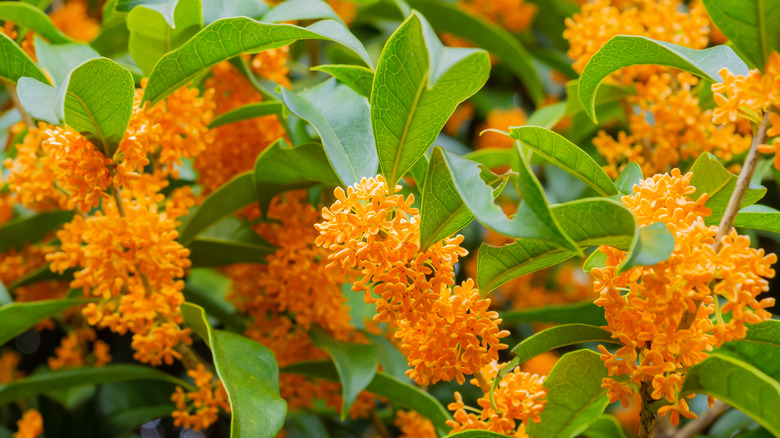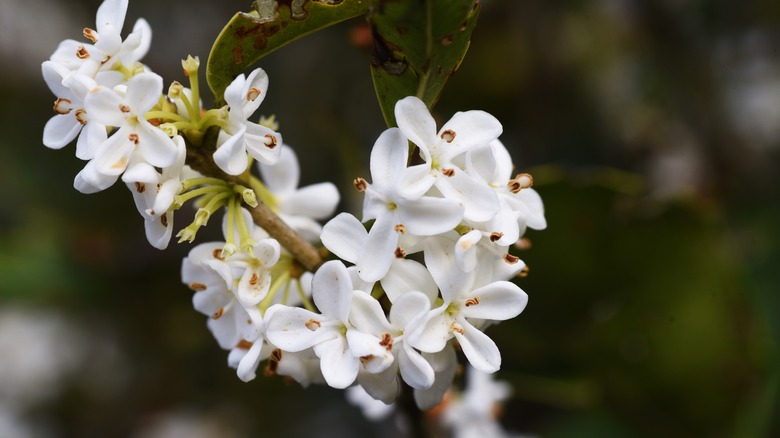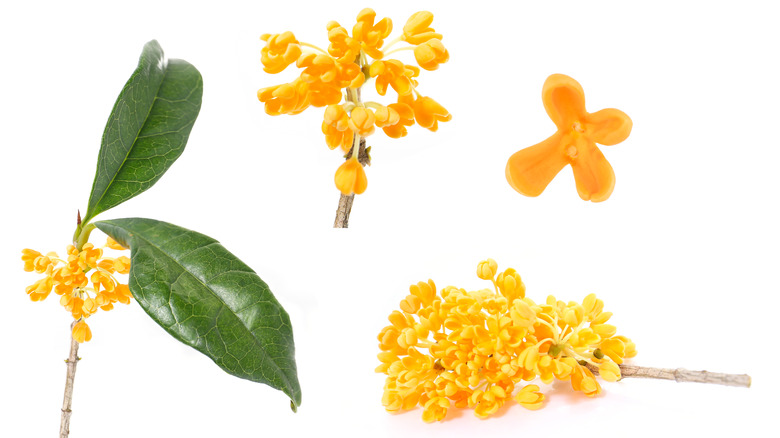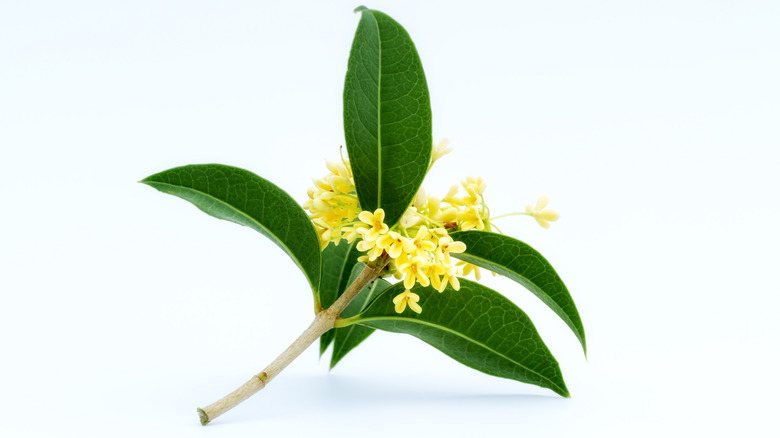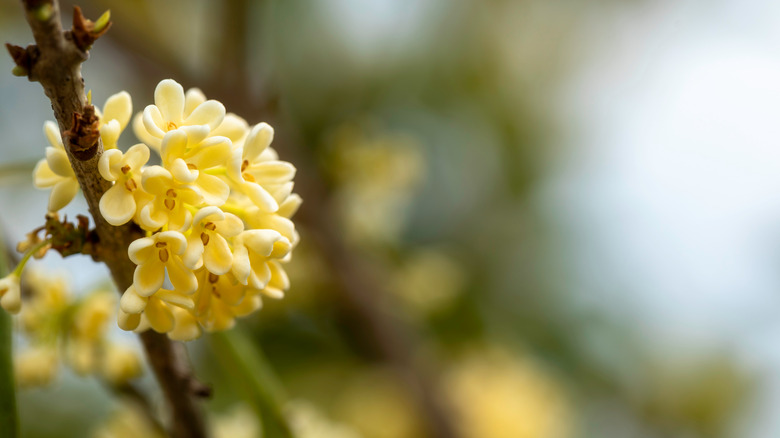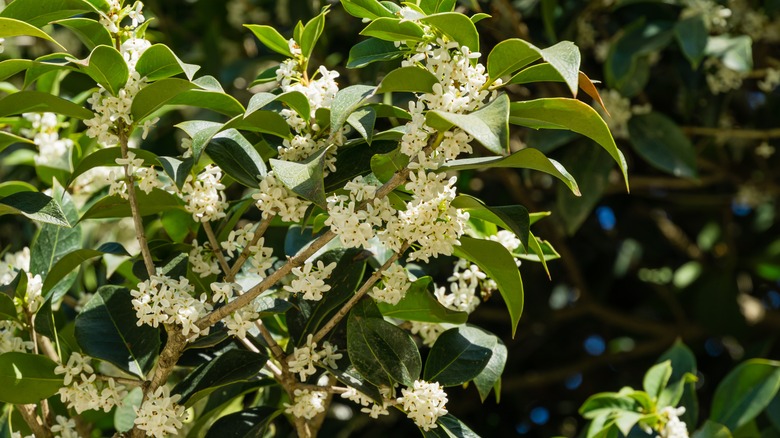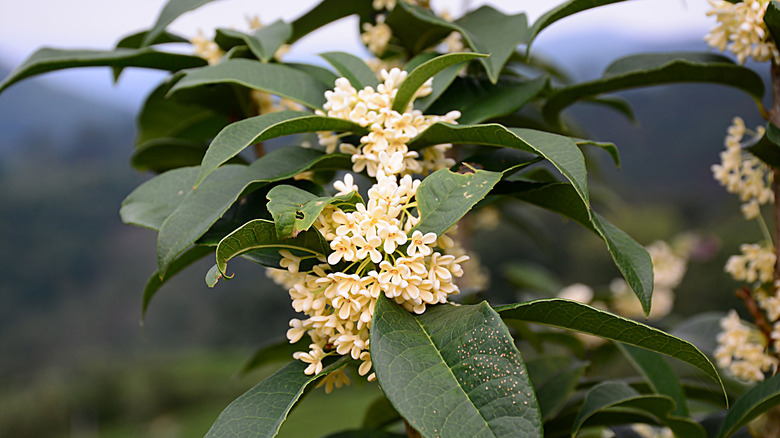How To Care For A Sweet Olive Flower
The sweet olive flower (Osmanthus fragrans) is a customary favorite among homeowners and businesses in Asian cities. The Frustrated Gardener reports that the scent of the sweet olive flower can be found everywhere in the Chinese cities of Hangzhou and Suzhou, which have made the plant their city flower. Known locally as guihua and internationally by the alternative moniker tea olive, the flower smells of peaches or apricots and bursts out into a dazzling orange flare of small, densely spaced flowers. It should be noted that some subspecies produce a range of colors that can display white flowers as well.
The sweet olive flower is a native of the Himalayan region, but local varieties (Osmanthus americanus) thrive in coastal regions of the southern United States; they can be found in abundance from Florida northward to Virginia, and often as far west as Louisiana (via Dave's Garden). This makes the plant a great addition to gardens in a number of different USDA hardiness zones (The Spruce suggests thriving growth in zones 8b to 11a).
Fragrance is the most powerful feature of this plant, and Dave's Garden is quick to point out that the light and fruity scent can be picked up from over 100 feet away during peak blooming times. This makes the flower a particularly interesting addition to any home that could benefit from a bushy flowering shrub (perhaps along borders).
How to use a sweet olive flower in garden
The Texas A&M University AgriLife Extension estimates that the sweet olive plant can grow to as tall as 20 feet with a 6- to 8-foot width. Even with more modest growth, this makes the plant a great option for crafting natural walling in your garden. Another feature of the plant is its lengthy flowering window, producing flowers ranging from orange to white, and even some that flower in a buttery yellow (via The Spruce). They bloom throughout the fall, winter, and spring seasons, with some carry over into the summer.
The most important thing you can do with this flowering plant, according to Texas A&M, is to plant it in a place where its scent can be best enjoyed. The small flowers offer a nice visual addition, but the most striking feature is certainly the aroma. Fortunately, homeowners can find success in this regard with a planting layout that either features this shrub prominently or one that hides it in the back of the garden in favor of other flowering plants.
Gardening Know How recommends planting these flowering bushes underneath windows that lead into heavily used seating areas as well as in places that surround outdoor relaxation spaces for the best sensory experience both inside the home and while enjoying the outdoor air. Adding these plants near a newly-built deck or patio can provide an immediate boost to the ambiance that you enjoy in this outdoor addition.
How to grow a sweet olive flower
For homeowners who already have a sweet olive at their homes, taking cuttings to propagate new bushes is simple. As well, for those purchasing a new sweet olive plant from their local nursery, a simple guide to rooting new shrubs in the garden will provide all the nuance you require to kickstart healthy growth and the flowering that will soon take place.
It's best to take cuttings in the period of wintertime dormancy. Purdue University's Extension reports that doing so allows the plant to make the most of its natural dormancy, preparing it to focus all its energy on creating new root growth as the weather begins to heat up once more — rather than leafy vegetation that would normally occur in a woody branch. Purdue also suggests saturating the parent plant a day before taking cuttings. Severed plant tissue is far less effective at taking in water, so ensuring that your cuttings are already well hydrated before making the separation offers a boost to the success rate of any new propagation. As well, removing most of the leaves that exist on the cuttings can help stem the loss of water, as leaf material sheds water more than any other surface on the plant.
The University of Illinois Urbana-Champaign suggests keeping cuttings in a cool place through much of the winter to allow for a seasonal normalization, although storing cuttings alongside fruits in a kitchen refrigerator is a no-go.
How to care for a sweet olive flower
According to the Texas A&M University AgriLife Extension, sweet olive plants are adaptive and can thrive in all but extremely sandy soil. These shrubs do well in USDA zones 8 to 10 and are best planted in moderately sunny or partially shaded areas.
The University of Maryland Extension provides guidance on watering during this early phase. It's beneficial to keep the soil routinely moist as your new plant establishes its root system. Once this takes place though (typically after about two years), it's better to water infrequently and with an aim to gain depth rather than wide and shallow watering: This helps roots to become more drought tolerant over the long term than plants that have a more frequent watering schedule.
The Royal Horticultural Society recommends digging a hole that's about three times as wide as the pot your new shrub came in, and just a bit deeper than it is tall. It's also a good idea to douse the plant's root ball before transplanting the bush in order to give it a great start in its new home. Den Garden recommends planting new trees and shrubs in the fall or early spring to give them the best overall conditions for rapid root growth and healthy foliage. Establishing roots as quickly as possible is a major component in the success of any new planting, and these times of the year can help speed this need along with ease.
Sweet olive flower varieties
There are a few sweet olive varieties of note, including the prototypical Osmanthus fragrans, which produces the signature orange flowers. Dave's Garden reports that the leaf cover in this variety presents early on as a brilliant bronze red.
- Clemson Extension reports a few cultivars of note, including the Goshiki, which means five colors in Japanese and sports a range of foliage color changes throughout the year and during stages of leafy development.
- The University also speaks of the Ogon variety, which produces golden yellow leaves that mature into a more muted yellow-green color over time. Clemson's team suggests keeping this cultivar in a partially shady area of the yard.
- Fine Gardening shares that the hybrid varietal, Fortune's Tea Olive (Osmanthus x fortuni) thrives in zones 7 to 11 and benefits from the additional cold hardiness of the False Holly plant that it's hybridized with. This sweet olive variety produces white flowers with the signature fragrance that is associated with all subtypes of the species.
Are sweet olive flowers toxic?
The sweet olive flower is an ornamental plant and while its flowering buds produce an intense scent, the plant's parts are not meant to be eaten. With this being said there are no reports of toxicity associated with the sweet olive flower, per Britannica, Clemson Extension, and The Spruce.
While caution should always be exercised, homeowners can typically rest assured that toxicity issues will not arise in the course of planting or caring for sweet olive flowers in the garden. This means that homeowners with pets, young children, or other considerations to make when planting new additions in the yard can enjoy the sweet fragrance that this shrub produces throughout most of the year — with peace of mind and confidence in the safety and security of the home. This is great news for homeowners that enjoy the fresh and fragrant aromas of peaches or apricots that are produced in the flowering season of the sweet olive plant.
How to repot a sweet olive flower
Homeowners can benefit from the use of pots when it comes to adding sweet olive plants to their yard. Planting in a container can help keep the overall shape and size of the shrub under control with greater regularity then one planted directly into the ground.
Because of the potential for sprawling growth, this is a great option for adding the sweet olive plant to any yard. Likewise, because of the typically muted proportion of flowers to leaf growth (primarily as a result of the miniature size of the blooming flowers), using pots or other containers to allow for mobility can help you bring these plants to the forefront while other elements of the garden shrink back during the colder months and push the plant to the background when the rest of the garden is in full bloom.
The Spruce recommends potting a sweet olive plant in soil that drains easily, and ensuring that the pot itself boasts a high volume of drainage holes to support the free clearance of excess moisture. When transferring to a new pot, ensure that the receiving vessel is 8 to 12 inches wider than the plant's root ball.
Using fertilizer with a sweet olive flower
The Spruce suggests that sweet olive plants won't need routine fertilizer additions as the plant itself is fairly low maintenance. Although, with any plant situated in a container or directly in the ground, adding compost for general soil mix in the event of routine erosion is important. The Royal Horticultural Society also recommends adding mulch in both the summer season and over winter to help manage moisture retention and protect against extreme temperature fluctuations that can occur during any point throughout the year (either in the form of extreme heat or chill).
These recommendations stand for sweet olive plants found in gardens across local regions and growing zones. The shrub is vibrant and can withstand routine fluctuations in soil makeup and temperature with grace. Finally, general maintenance that includes trimming, watering, and soil protection is all it will take to help a sweet olive plant thrive in your home garden.
